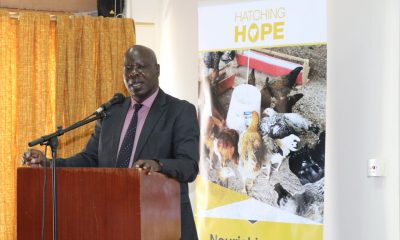Poultry farmers in Nakuru last year netted Sh 875 million from the sale of 67 million eggs.
County Livestock and Fisheries Chief Officer Dr. Enos Amuyunzu said a further Sh489 million was earned from the sale of 825 tons and 340 tons of chicken and turkey meat respectively.
He spoke after signing a Memorandum of Understanding with Heifer International, an agricultural technology (Agritech) and research firm that is targeting to link 2,500 poultry farmers in the county to markets and certified animal feed manufacturers.
Dr. Amuyunzu said the department of agriculture has in the past five months distributed 43,400-day-old chicks to 241 farmer groups across the county, while 110 Cooperative societies had received 96 automatic chicken incubators and backup generators valued at Sh 6.8 million
In July, area governor Lee Kinyanjui rolled out a Sh16 million programme aimed at improving breeding and multiplication of indigenous chicken.
The project by the County government aims at empowering farmers in eleven sub counties to produce 1.5 million eggs worth Sh 15 million monthly.
Dr. Amuyunzu said the country had embarked on supporting the poultry value chain through distribution of 10,000 fertilized eggs to 28 farmer groups.
“Nakuru now has approximately 1.5 million indigenous chicken, 18,300 improved Kienyeji breed, 212,200 layers, 275,900 broilers, 44,000 turkeys, 73,000 ducks and 14,500 geese.
The County is exploring the possibility of intensifying poultry vaccination in order to cushion small-scale farmers against the high vaccination costs as well as the high disease outbreaks,” said the Chief Officer.
Commercializing the indigenous chicken sector, he said, was facing several challenges among them frequent disease outbreaks, poor access to improved breeding stock, inadequate management skills, knowledge and information leading to poor productivity and loss of market opportunities.
Dr. Amuyunzu said the two levels of government were working on strategies that will address challenges stifling the industry by streamlining market channels to ensure cheaper feeds, shorter production period, and shorter supply chain and guaranteed market.
He noted that with good management, the poultry sector was the best for farmers given its resilient nature.
Heifer International Business Development Officer Mr. Nathaniel Otieno said the venture also aims at training poultry farmers on hatching and proper care of the birds.
Elsewhere, County Executive Committee Member for Agriculture Dr.Immaculate Maina said her department was promoting adoption of improved Kienyeji breed by poultry keepers.
She said the second batch of 3,800 improved Kienyeji chicks had been distributed to 24 women and youth groups in Kiratina area of Menengai East Ward, within Nakuru East Sub-County.
250 farmers in Kiratina received the first batch of 7,600 improved Kienyeji chicks which Dr. Maina said require no special care and can be fed just like other indigenous chicken, hence low cost of production.
The chicks she noted are improved to endure diverse climatic conditions and are highly tolerant to common chicken diseases like new castle.
“The project has been fashioned to promote urban agriculture while ensuring the use of limited available space to feed the growing population in urban centers. Our ultimate goal is to achieve food security and nutrition as well as create employment.
We want to improve the livelihoods of Nakuru people mainly through women and youth. The project will enable them to take care of the needs of their families. It will also help them pay school fees for their children,” said the CEC.
To ensure that the small holder farmers realize optimum production, the county government has attached a veterinary and a livestock extension officer to the project who will equip the breeders with necessary technical advice such as how to feed the birds and administer vaccines.
Four farmer groups in Njoro Sub County had received 3,850 Kienyeji improved chicks, while in Naivasha Sub-County 1,900 chicks had been distributed to farmers in Biashara Ward.
The County government has also donated 5,100 chicks to various groups in parts of Nakuru West Sub-County. The devolved unit is targeting to distribute an additional 29,700 hens and cockerels within the next six months.
Dr. Maina said her department was also collaborating with Kenya Agricultural Livestock Research Organization (KALRO) in ensuring farmers got improved Kienyeji chicken breeds that were high yielding, fast maturing, easy to maintain and disease resistant that have the ability to lay 220-280 eggs in a year, double the yield capacity of ordinary indigenous chicken.
Depending on what the farmer wants, the bird can be managed to produce eggs or meat. When managed as a broiler with commercial feeds, it can achieve 1.5 kg in seven weeks, or after three weeks of brooding it can be managed on free range with minimal supplementary feeding and be ready for consumption or sale after 10 to 14 weeks, according the Agriculture CEC.
“KALRO has previously distributed about 1.5 million day old chicks to farmers in Nakuru. More than 700,000 farmers have been trained on basic disease control and management mechanisms and best practices in poultry farming.
The poultry sub-sector has the potential to transform Kenya’s economy and improve the well-being of Kenyans. Agriculture contributes 26 per cent of the Gross Domestic Product (GDP) directly and 27 per cent indirectly in Kenya, 30 percent of this comes from the poultry sub-sector. This is a big contribution to Kenya’s GDP,” said Dr. Maina.
The county had also trained and linked extension officers with poultry farmers as it continues to work out marketing channels for live birds and poultry products to avert exploitation by brokers.
By Anne Mwale





